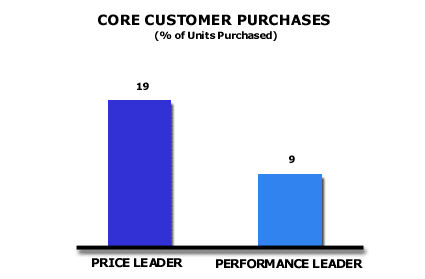Analysis 42: Target Customer Purchases By Price Point
EXHIBITS:

HOW TO INTERPRET THE ANALYSIS: This exhibit shows the purchasing patterns for a company's target Core customer purchases. The percentage measures the units of the total purchases by the target customer segment. This company's target Core customer group purchases 19% of its total purchases at the Price Leader Price Point and 9% at the Performance Leader Price Point. Assuming that there are no Next Leader products in the market, the remaining 72% of this target customer segment purchases are at the Standard Leader Price Point. If a company with this target customer segment would decide to withdraw from, or not offer, one of these two Price Points, these sales would be in jeopardy.
PURPOSE: This analysis quantifies the percentage of their total purchases that the target Core customer segment buys at the Performance Leader and Price Leader price points. The company would use this analysis to determine the risk it incurs by failing to cover price points purchased by its target customer segment. APPROACH: The company's marketing and sales staff surveys customers and makes estimates of the purchases by price point of its target customer segment. This analysis is best done using units as the basis of measuring market share, however, if units are not available, dollar purchases will be adequate. This analysis assumes that the company undertaking it is a Standard Leader considering coverage of Performance Leader and Price Leader price points. The same analysis can be done if the company is a Performance Leader or Price Leader. Once the company has completed this analysis, it should evaluate the risk it incurs by the decision not to cover a price point its target Core customers purchase today or could purchase in the near future. If the target customer segment would view the company's decision not to cover a price point as a "failure", then the company incurs significant risk by not covering the price point. This "failure" opens the company's Core relationships to other suppliers and may foreclose the company's entrance into other potentially attractive customers in its target customer segment.
Examples of: |
|
Recommended Reading |
| For a greater overall perspective on this subject, we recommend the following related items:
Analyses: Symptoms and Implications: Symptoms developing in the market that would suggest the need for this analysis.
Perspectives: Conclusions we have reached as a result of our long-term study and observations.
|
